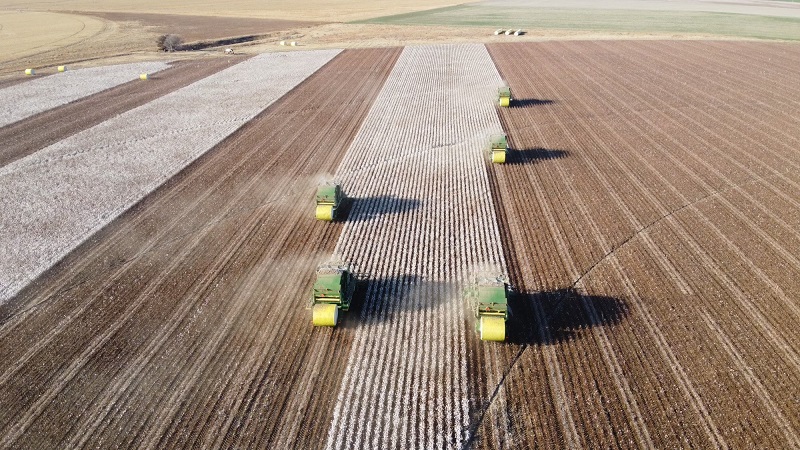Answering Opportunity’s Knock
Dusty Hoskyn was looking for a way to diversify his rice and soybean operation this past spring. When an adjacent cotton farm became available, he took the plunge, planting his first-ever cotton crop of 1,400 acres. And he named his new cotton venture appropriately, calling it “The Cotton Farm.”
“I never dreamed that land would become available,” Hoskyn says. “The cotton business is interesting. Farming is shifting toward diversification. I don’t think you can put all of your eggs in one basket anymore. If you have one bad year and have only one crop, that’s the end of it.”
Hoskyn added two men to his labor force, and would have added another, but “we just couldn’t find anyone.” Which is not at all unusual these days. He also added one tractor, a new planter and a leased cotton picker.
“We got by okay,” he adds. “With bigger equipment, it’s amazing what you can get done in a day. So far, so good.
“It was strange – I didn’t know the first thing about cotton until this year,” he continues. “Growing up, I thought all the things you had to do to a cotton crop looked like a circus. But the technology is amazing – it’s amazing what you can do with the technology you have with cotton that you don’t have with other crops.”
In addition to cotton in 2007, Hoskyn had 1,500 acres of soybeans and 3,000 acres of rice on his farm in the east central Arkansas River valley near Keo. But let him tell you where he is actually from: “I’m not sure where I’d call home. My house is close to Toltec, I have an England (AR) mailing address and a Little Rock phone number.”
In the fall of 2006, Hoskyn planted 600 acres of wheat and hoped to plant 1,100 acres this fall. The plan is to plant double-crop soybeans next spring, weather permitting.
As for yields, Hoskyn says, despite harvest-time rain, he’s optimistic: “With all the rain we’ve had, there is a considerable amount of cotton on the ground. But we’re hoping for two bales (per acre).”
Eye-Opening Experience
Nothing with growing cotton in particular caught Hoskyn off guard, but the experience was eye-opening, he says. For one thing, he’d obviously never operated a cotton picker. And for another, he’d never planted a crop on rows. His leased picker was a 6-row Deere model 9996, and the planter was a 12-row Deere model 1720.
“Dealers don’t want to lease pickers,” he says, “but there were so many sitting around that they had to do something. We wanted to pick it all with one picker, and it has worked fine.”
Anything else unusual about a picker? “A picker is an entirely different machine,” Hoskyn says. “It’s almost like having a spaceship.”
Marketing his crop was a also a new experience for Hoskyn, and for that, he put his cotton in a Staple Cotton Cooperative Association pool. “That’s made it awfully easy for me,” he explains. “And of course, it just seemed like the right thing to do because of the trend in the cotton market – it has been going up.”
And in 2008?
The recent higher-price bump in the cotton market has been enough for Hoskyn to go for cotton crop No. 2 in 2008.
“We’ll probably change some acres a little bit according to what prices do,” he says. “I hope prices will be better next year, and it looks like they will be.”
He may also plant corn for the first time in ’08, and that too will be price-driven. But as with most anything, there’s always a “but.” “Grain prices sound exciting,” he says, “but from a farmer’s standpoint, everything else has gone up, too. It’s relative. I don’t think the windfall will be as much as people think it will be.”
One of the inputs that has increased in price in proportion to the spike in grain prices is nitrogen fertilizer, with urea around $400 per ton at the moment. In 2007, Hoskyn put out 200 pounds of urea per acre, or 92 units, at a cost of $40-$45 per acre. The price for nitrogen on corn could be double that.
“I’d like to add a little corn next year, but not on our cotton ground,” Hoskyn says. “We’ve got some other ground that is sort of sandy, and with corn prices what they are, we’ll plant some.”
And another “but”: “But we have storage,” he adds. “That’s something you have to look at.”
Technologically Speaking
Hoskyn had experience with Roundup Ready soybeans, and he says, “It’s amazing the weed control you can get. There are problem (weeds) that you just don’t have to fight anymore. I was not around cotton before, but I can remember in soybeans we just had to fight them to no end.”
But his experience with the Bollgard/Bollgard II genes in cotton was something new. “Bt technology has been great,” he says. “If you look at our refuges, you see the damage worms can do.”
“We wound up having to spray for worms one time in the Bollgard II cotton, and twice in the Bollgard,” says his consultant Don Johnson.
Hoskyn planted four Deltapine varieties: 455 BG/RR, 455 BG/RR, 117 B2RF and 164 B2RF.
Captions:
Dusty Hoskyn
James Phillips
(From left) Don Johnson, James Phillips, Bodie Cobb, and Dusty Hoskyn.








